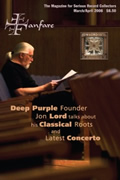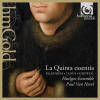Texte paru dans: / Appeared in:

Fanfare Magazine: 31:4 (03-04/2008)
Pour
s'abonner / Subscription information
Les abonnés à Fanfare Magazine ont accès aux archives du
magazine sur internet.
Subscribers to Fanfare Magazine have access to the archives of the magazine
on the net.
HMG501922

3149020192214
The title of this program, “La quinta essential” means quintessence, elaborated on the cover as “the quintessence of a musical art . . . the three dominant styles of the Renaissance: the Roman school, Franco-Flemish polyphony, and English late Gothic.” The three representatives are characterized as “Lassus, counterpoint on a human scale, Palestrina, the path of transcendence, and Ashewell, the irresistible appeal of virtuoso ornamentation.” (I have spelled it Ashwell in the headnote to correspond to standard listings.) Ashwell is called “something of an odd man out,” and indeed he does not come from “a generation immediately preceding” the other two, but two generations before them. Either Tallis or Byrd would have been closer in time to the others. But despite his small surviving output of two masses (the other one recorded by Stephen Darlington, 23:1), his work does make the comparison that van Nevel seeks to establish by juxtaposing the three masses. Ashwell’s “rhythmic diversity and complexity” are “a complete contrast to Palestrina’s meditative counterpoint.”
If I have quoted van Nevel’s notes more than usual, it comes from an acquaintance with his long series of recordings, where he has consistently investigated the byways and backwaters of early modern repertoire. The same inquisitive mind is at work elucidating the point underlying this program. This is the third time van Nevel has had a go at the Lassus Mass. He included the last two movements in a collection (RCA 30815), then recorded the entire Mass (Sony 60705). The Palestrina Mass has been recorded several times without ever being reviewed here. A Fonè disc from Italy containing this and two other Palestrina masses under Antonio Sanna may have been the best way to hear it until now. Van Nevel sees just as much contrast between Lassus and Palestrina as anyone will see in comparing the Renaissance examples with Ashwell’s earlier style. The adjectives he applies are “unearthly” (for Palestrina) and “terrestrial” (for Lassus). One composer directed in Roman churches, the other at the ducal court in Munich. I’m pleased to see that van Nevel did not choose to widen the difference between the two by employing instruments for the Lassus Mass, as some conductors do (while most recordings of Lassus masses are a cappella, all of Palestrina’s are). He makes his point sufficiently well as it is. He chooses a cantus firmus mass of Palestrina and a parody mass of Lassus, even though both composers employed both approaches (admittedly, Lassus’s cantus firmus masses are early and few).
In the end, van Nevel has chosen three masses that need attention on disc and made of them an object lesson in listening to music. The performances are up to his usual high standard; indeed, a complete run of his recorded output would stand up to any other early-music ensemble’s collection. This label has issued his seven most recent discs, and with any luck will continue to do so. Highly recommended.
Cliquez l'un ou l'autre
bouton pour découvrir bien d'autres critiques de CD
Click either button for many other reviews


